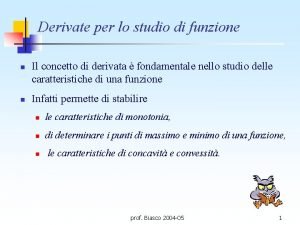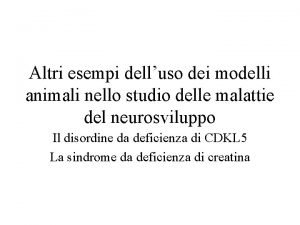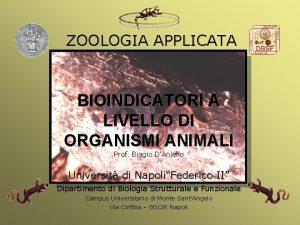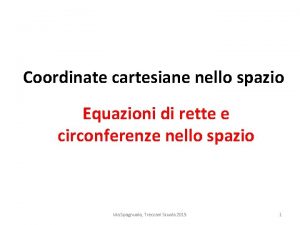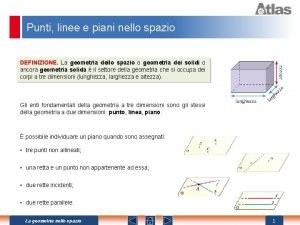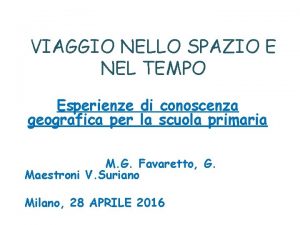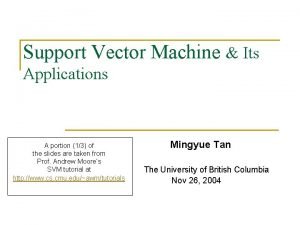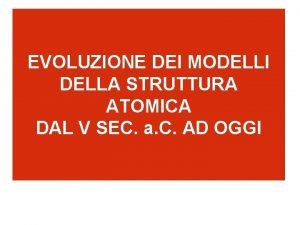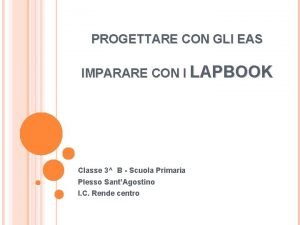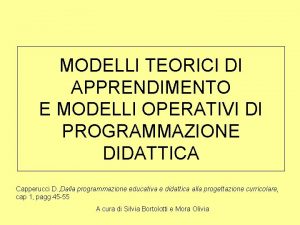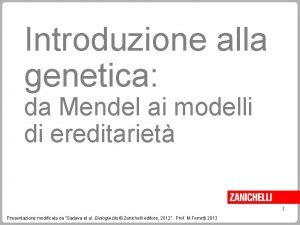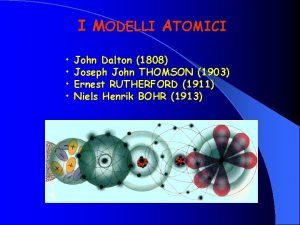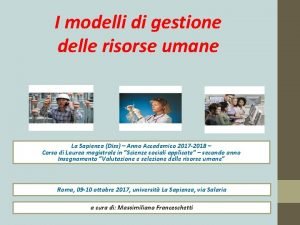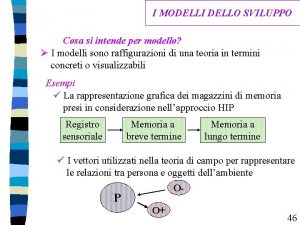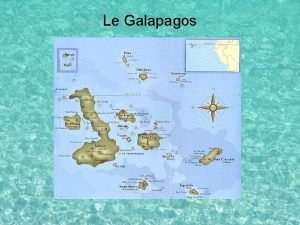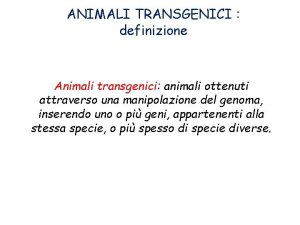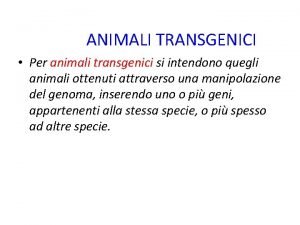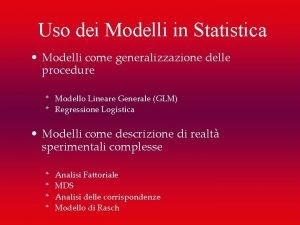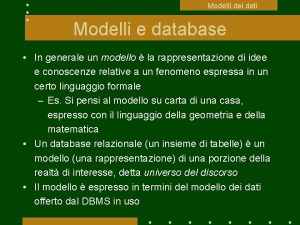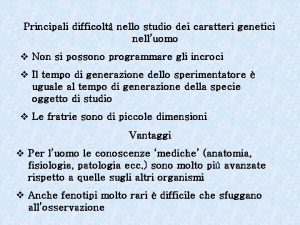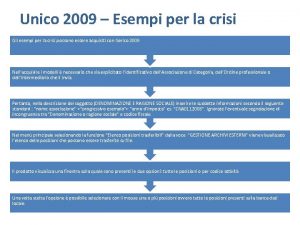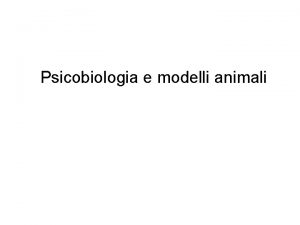Altri esempi delluso dei modelli animali nello studio

































- Slides: 33

Altri esempi dell’uso dei modelli animali nello studio delle malattie del neurosviluppo Il disordine da deficienza di CDKL 5 La sindrome da deficienza di creatina

The CDKL 5 disorder (formerly The Hanefeld variant of Rett syndrome) • Described by Markolf Hanefeld, 1984 • Associated with cyclin-dependent kinase-like 5 (CDKL 5) gene mutation that is located on the X chromosome • Characterized by seizures in the first months of life with subsequent development of RTT features • No regression after period of normal development as in classic RTT • Altered development of cognitive and motor function • Stereotypies • Severe hypotonia • Autonomic dysfunctions • Severe deficits in visual processing, sideways glance and abnormal eye tracking Incidence estimated at 0. 21/100, 000 live births (Hector et al. 2017)

What is CDKL 5? It is a serine-threonine kinase, highly conserved among vertebrates, pathogenic missense mutations in patients clearly cluster within the amino(N)-terminal kinase domain of CDKL 5, suggesting that perturbed kinase function likely underlies the pathophysiology of the disorder It is highly expressed in the brain, and in particular in the forebrain with an increase in expression during early postnatal life, it is present both in nucleus and cytoplasm and it is enriched in synaptic structures (post-synaptic density, dendritic spines)

A SYNAPTIC DISEASE • CDKL 5 Peak expression during synaptogenesis • Synaptic interactors • Alterations in excitatory and inhibitory puncta • Dendritic spines are unstable

TWO-PHOTON IMAGING ALLOWS STUDIES OF INDIVIDUAL SPINES IN A MOUSE MODEL OF CDKL 5 DISORDER PYRAMIDAL NEURONS - In vivo - Same dendrite over time - Gain and loss

Impairment of Long. Term Spine Survival in Cdkl 5−/y Mice P 50 P 80 Excessive loss of spines Della Sala, Putignano et al Biological Psychiatry 2015 P 50 P 80

PI 3 K How can we try to prevent this synaptic deficits? Akt IGF 1 can activate the Aktm. TOR pathway which is downregulated in CDKL 5 KO mice m. TOR S 6 Ks P S 235 -6 P S 6 Protein synthesis S 240 -4

IMAGING IN VIVO IGF-1 STRUCTURAL SYNAPTIC PHARMACOLOGY NO TREATMENT The advantage gained with the treatment is not lost

To use sensory processing to reveal abnormalities in synaptic integration

Biomarkers: Indicators of biological or pathological processes and response to drug intervention. They can be biofluids evaluated with molecular or biochemical techniques; tissue analysis; functional measures (eg EEG, f. MRI) Good biomarkers: • Great sensitivity, specificity, accuracy, high predictive value, quantitative • Safe and easy to measure • Cheap to assess CDKL 5 has established synaptic actions: Functional biomarker

Similar data for PSD-95

To use visual processing to reveal abnormalities in synaptic integration

INTRINSIC OPTICAL SIGNAL (IOS) IMAGING

REDUCED AMPLITUDE OF IOS VISUAL RESPONSES Mazziotti R. *, Lupori L. *et al. 2017

SLIGHTLY IMPAIRED VISUAL FUNCTION Mazziotti R. †, Lupori L. † et al. 2017

VISUAL RESPONSES ARE A ROBUST BIOMARKER Early deficits predict late deficits Mazziotti R. †, Lupori L. † et al. 2017

The visual biomarker • Allows for longitudinal studies • Readily translatable to humans • Highly quantitative nature • Predictive of behavioral impairments? • Depending on a defined brain structure? • Responsive to treatment?

OPERANT CONDITIONING SETUP Giulia Sagona Raffaele Mazziotti

Impulsive behavior in CDKL 5 mutants

The phenotype is present also in female mutants

Prolonging the «No go» period impairs solving the task

Behavioral alteration Behavioral deficit is correlated with the visual biomarker KO mice only Visual response impairment

The visual biomarker • Allows for longitudinal studies • Readily translatable to humans • Highly quantitative nature • Predictive of behavioral impairments? YES • Depending on a defined brain structure? • Responsive to treatment?

The visual biomarker • Allows for longitudinal studies • Readily translatable to humans • Highly quantitative nature • Predictive of behavioral impairments? YES • Depending on a defined brain structure? • Responsive to treatment?

THE VISUAL SYSTEM

NORMAL RETINAL MORPHOLOGY Antonia Stefanov Elena Putignano Debora Napoli Enrica Strettoi Synaptotagmin Calbindin. D Ct. BP 2/RIBEY E PKCα Connexin 36 Müller glial cells Lupori et al. 2019

SPINE AND SYNAPTIC ABNORMALITIES IN d. LGN and V 1 Claudia Fuchs Dendritic spines PSD-95 Lupori et al. 2019

RESPONSE DEFICIT IN ABSENCE OF CORTICAL CDKL 5 Emx 1 -CRE driver line Lupori et al. – under review

The visual biomarker • Allows for longitudinal studies • Readily translatable to humans • Highly quantitative nature • Predictive of behavioral impairments? YES • Depending on a defined brain structure? YES • Responsive to treatment?

The visual biomarker • Allows for longitudinal studies • Readily translatable to humans • Highly quantitative nature • Predictive of behavioral impairments? YES • Depending on a defined brain structure? YES • Responsive to treatment?

PROTEIN BASED THERAPY Prof. Elisabetta Ciani Claudia Fuchs Trazzi et al. – 2018

The visual biomarker • Allows for longitudinal studies • Readily translatable to humans • Highly quantitative nature • Predictive of behavioral impairments? YES • Depending on a defined brain structure? YES • Responsive to treatment? YES

Nel modello CDKL 5 abbiamo potuto comprendere molti dei possibili usi di un modello animale di malattia: Comprensione delle basi molecolari (conoscenza degli interattori) Conoscenza di meccanismi cellulari alterati (sinapsi e spine dendritiche) Possibilità di recupero Idee per studi di biomarcatori nell’uomo
 Estremanti di una funzione
Estremanti di una funzione Studio animali
Studio animali Scorpione oviparo
Scorpione oviparo Tutti gli invertebrati
Tutti gli invertebrati Esempi di animali cordati
Esempi di animali cordati Doping nello sport
Doping nello sport Pia de tolomei treccani
Pia de tolomei treccani Batterio nello stomaco
Batterio nello stomaco Rette nello spazio
Rette nello spazio Piani secanti definizione
Piani secanti definizione Devianza nello sport
Devianza nello sport Viaggio nello spazio scuola infanzia
Viaggio nello spazio scuola infanzia Nello x3k
Nello x3k Disvalori nello sport
Disvalori nello sport Retta nello spazio
Retta nello spazio Xna game studio express
Xna game studio express Xna game studio visual studio 2017
Xna game studio visual studio 2017 Evoluzione modelli atomici
Evoluzione modelli atomici Lapbook invertebrati
Lapbook invertebrati Modelli di apprendimento
Modelli di apprendimento Classificazione modelli didattici
Classificazione modelli didattici Struttura organizzativa
Struttura organizzativa Modelli di programmazione lineare
Modelli di programmazione lineare Da mendel ai modelli di ereditarietà
Da mendel ai modelli di ereditarietà John dalton 1808
John dalton 1808 Razionalità sinottica
Razionalità sinottica Modelli di gestione delle risorse umane
Modelli di gestione delle risorse umane Modelli deterministici psicologia
Modelli deterministici psicologia Kounin glasser jones
Kounin glasser jones Modelli di erogazione dell'assistenza infermieristica
Modelli di erogazione dell'assistenza infermieristica La chimica è lo studio dei cambiamenti
La chimica è lo studio dei cambiamenti Studio dei minerali
Studio dei minerali Pitoui testanera
Pitoui testanera Arctocefali
Arctocefali
